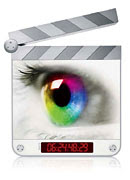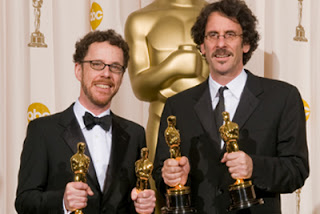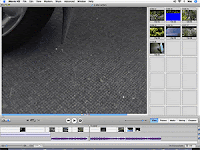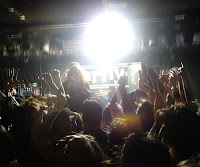G324 Lucy Mannall
This is my A2 media coursework blog. I will be creating a music video for the song 'Confessions' by 'We Are The Ocean'. The project also involves creating a digipak album and a magazine advert for the digipak.
I am working in a group with:
Saturday 26 March 2011
Evaluation Question 1:
In what ways does your media product use, develop or challenge forms and conventions of real media products?
- The conventions that were in our music video were the stereotypical ones of the alternative rock and post-hardcore genre and I think that we followed them quite well with the resources and limited time that we had as A2 level media students.

- We collected our performance footage from an actual gig that We Are The Ocean did in Leeds at 'The Cockpit' (Mary filmed this on her HD camera). This was so that it could have lots of verisimilitude and be as real as we could make it. A performance footage aspect is quite often used most of the time within music videos in the genres of alternative rock and post-hardcore so we decided it would be a very good idea to use it in ours and it would also break up the narrative aspect of the video a little bit more for some variety and to keep the audiences attention and also to add more depth so we don't just have the narrative part.
- Fast paced editing was also used by us which matched the music because this is also a very key stereotypical convention to the genres that we were working in (post-hardcore and alternative rock).
- We have also included lots of different angles within the video to make it more interesting for the audience. When we were filming at the shoot we made sure that we took loads of coverage shots so it gave us lots more scope to work with and we could fall back on it them if we got back into the editing suite and found we didn't have enough, this would hopefully save us from doing lots of re-shooting of the material and we found that the extra shots that we took that we didn't plan actually worked really well in some places and are better than the shots and takes that we planned at first on the call sheet.
- For the magazine advert and digipak album we looked at existing articles and digipaks to get inspiration from. So for this we looked at 'NME' and 'Kerrang' especially to see specific real life examples and what the normal layout was and what we thought did and did not work. We Are The Ocean have been featured quite a few times in 'Kerrang' before so we thought that magazine especially would be a good place for us to advertise our digipak album.
- We added a blue colour filter to the music video and digipak to create the social realist feel and show the grittiness of the central protagonist's life colour filters are also very common in other music videos from the genres that we were working within. We also used realistic settings and locations within our video which created verisimilitude. We featured the same protagonist all the way through and brought in a few others that were very stereotypical and stock characters (such as brother, ex, friends etc) throughout to give the narrative more depth. Her clothing was also very typical to the genres that we had chosen to work in. She wore a white dress and had lots of black make up around her eyes. We got this idea from a 'Paramore' video for 'Emergency' in which Hayley Williams (the lead singer) wears a white dress and also has big black make up around her eyes we decided to copy this convention and use it within our video and also the target audience would recognise it as a convention and would be more likely to tell other people about the video and consume it more than just once.
- Overall we think that our video generally uses and develops the typical conventions of a music video from our genre but we did find quite a few limitations in making the video as we are just 17 and 18 year olds in sixth form making our own music video. We had limited equipment, resources and time but taking this in to consideration we are both really happy with the final outcome.
Evaluation Question 2:
How effective is the combination of your main product and ancillary texts?
- All of our 3 ancillary texts compliment and flow from each other by having the same features, using the same text font and using the same colour schemes all the way through.
- However there is a bit of a problem with discussing them as a promotional package. In the real world bands would go to 3 different companies to get each separate media text. These companies would include 'WeWow' which are a cd replication, duplication and packaging company and others etc so we have had quite a hard task to create all 3 of the products with the limited resources that we had.
- The same target audience applies for all 3 of the products, and all are promoting the band in some way or another.
- We included on the digipak a special edition sticker so that it would get more sales if we were to sell it in the real world and it also adds a personal touch to it and are a very effective technique to push sales as far as they can.
Evaluation Question 3:
What have you learned from your audience feedback?
- We have learnt lots about how to improve our work and listen to peoples advice and critisims and take them into account during all of the process of making all 3 of the products and ancillary texts.
- It was also good to see what people other than me and Mary who haven't seen it before could look at if rom a fresh insight and angle and give us feedback from how they see it and whether or not it works as a product and in different contexts and situations with different age differences.
- From our feedback from lots of different places such as Facebook, Youtube, Family, Friends, Twitter, and in class etc. we have found out that we need to look at our product in close detail and shot by shot and decide if the framing and editing of each shot and any general camerawork is of a very high standard enabling us to achieve higher marks and get us into the top grade bands. We used lots of precision when editing and wanted to make sure that we used the footage that we shot, and the editing opportunities that we had to the fullest because in Final Cut Express 4 (the editing program we used to edit the music video) there are so many effects and tools that are available and that can be applied so we used the audience feedback to help us in every stage and especially the target audience because they are the ones that our music vide is aimed at.

- Audience feedback has changed and reinforced our ideas quite a many times during the whole process. From it we have decided to add more characters to the narrative part of the video to add exposition as to why Emily is running away from home and also so that we could add in lots more shot variation and difference to the editing and effects that we used. We have also done quite a few re-shoots of scenes because of audience feedback and most of the time the audience feedback has been really positive for us and encouraged us quite a bit because people were really impressed with what we had come up with and they thought that what we were producing was something to the same standard as a music video that a top band would make and create.
- When screening our work to get audience feedback on it we found that it's absolutely necessary to make sure you have pen and paper available to take notes about the feedback and also any recording equipment (such as voice recorders, cameras, tapes etc) are all set up and working before so you aren't wasting peoples time. Me and Mary both found that it's also necessary to explain to people and put into context what you are screening/ showing people and what context it's in and if there is anything in particular that needs looking and or feedback from a certain part or take etc for them to analyse, then you explain what that is so they can look out for it and it gives them time to think about it and therefore give better feedback.
- Getting feedback from different age ranges was also very useful because we go to see how they consumed the music videos and what quite a wide range of people thought about the video and other ancillary products.
Evaluation Question 4:
How did you use new media technologies in the construction and research, planning and evaluation stages?
Exmples of different technologies and in what parts we have used them for..

Research and Planning:
 Professionals within the media industry such as directors and the Cohen Brothers especially (for their new film 'True Grit') (this was mentioned on the Final Cut mini website on the Apple website very recently) use Final Cut (the very same editing software programme that we used and worked with to create our music video) in the post production process of making their films. This proves that it's a very good piece of software and the effects and tools that are on it must be good if professionals like them are using it in their editing process. Time has changed and in past years editing suites have been massive places with lots of desks to do not very much work at all but recent technological advances have made things like this available to do and editing and most of the post production process can now be done on an apple mac even on the move. In the article they talk about how they only had a very short and limited amount of time to edit and produce the film in so they chose to use "Final Cut because of its efficiencies and speed, enabled us to meet the deadline"
Professionals within the media industry such as directors and the Cohen Brothers especially (for their new film 'True Grit') (this was mentioned on the Final Cut mini website on the Apple website very recently) use Final Cut (the very same editing software programme that we used and worked with to create our music video) in the post production process of making their films. This proves that it's a very good piece of software and the effects and tools that are on it must be good if professionals like them are using it in their editing process. Time has changed and in past years editing suites have been massive places with lots of desks to do not very much work at all but recent technological advances have made things like this available to do and editing and most of the post production process can now be done on an apple mac even on the move. In the article they talk about how they only had a very short and limited amount of time to edit and produce the film in so they chose to use "Final Cut because of its efficiencies and speed, enabled us to meet the deadline"
Exmples of different technologies and in what parts we have used them for..

Research and Planning:
- Blogger, Facebook, Youtube, Twitter, Megavideo, Vimeo, Amazon, Pla.com, IMDB, Google, Google Books, The Guardian, Kerrang, NME, Q, Mojo, Wikipedia, Scribd, Divvshare, The scanner, portable harddrive, email, Skype, Msn messenger, Podcast recorder, DV Video cameras, iMovie 06/08, 'Money For Nothing' book and 'Experiencing Music Video' book by Carol Vernaillis.
- Standard definition dv cameras, high definition (HD) cameras, iMovie 06/08, Final Cut Express 4, Coral Draw, Quicktime (media player), VLC Media Player, iTunes, a digital SLR camera, podcast recorder and most of the technologies from research and planning as well.
Evaluation:
- video cameras, hyperlinks and pictures (to make the blog interesting and attractive so people will read content from it), Youtube, Scribd, various books, screen captures and also many of the technologies and programmes mention in the research and planning and also constructions and exhibition stages. Blogger really helped me to make my work interactive, appealing and very easy accessible for others to get to and consume.

We used Final Cut to edit our footage and the music video as a whole and we really feel like we have tried to use all of its tools and effects to the maximum. At first we found it quite hard to get used to as it's quite a big jump up from iMovie 06 that we used in our AS project but after not much much time at all we quickly got used to it's functions. It's definitely a big step up from using iMovie 06 last year because there is just so much more complex and there is lots of scope available for creativity and our video would just not be the same at all if we had cut and edited it and done all of the post production on iMovie 06.
 Professionals within the media industry such as directors and the Cohen Brothers especially (for their new film 'True Grit') (this was mentioned on the Final Cut mini website on the Apple website very recently) use Final Cut (the very same editing software programme that we used and worked with to create our music video) in the post production process of making their films. This proves that it's a very good piece of software and the effects and tools that are on it must be good if professionals like them are using it in their editing process. Time has changed and in past years editing suites have been massive places with lots of desks to do not very much work at all but recent technological advances have made things like this available to do and editing and most of the post production process can now be done on an apple mac even on the move. In the article they talk about how they only had a very short and limited amount of time to edit and produce the film in so they chose to use "Final Cut because of its efficiencies and speed, enabled us to meet the deadline"
Professionals within the media industry such as directors and the Cohen Brothers especially (for their new film 'True Grit') (this was mentioned on the Final Cut mini website on the Apple website very recently) use Final Cut (the very same editing software programme that we used and worked with to create our music video) in the post production process of making their films. This proves that it's a very good piece of software and the effects and tools that are on it must be good if professionals like them are using it in their editing process. Time has changed and in past years editing suites have been massive places with lots of desks to do not very much work at all but recent technological advances have made things like this available to do and editing and most of the post production process can now be done on an apple mac even on the move. In the article they talk about how they only had a very short and limited amount of time to edit and produce the film in so they chose to use "Final Cut because of its efficiencies and speed, enabled us to meet the deadline" If the Oscar winning Cohen brothers use software such as final cut to edit some of their films then it must be a good program and especially as we are only A2 media students it gives us a great head start to go onto creating other films, music videos and just projects in general that could one day help us to win some awards!
Friday 25 March 2011
Ancillary 1: Digipak Album
This is the final draft of our digipak album:
(we also decided to add a 'special bonus edition' sticker to make it more authentic and reflect a project from the real media industry).
Wednesday 23 March 2011
MJ- The Performance Footage
 To get the performance footage I (Mary) went to a 'We Are The Ocean' gig at the Cockpit in Leeds. She took her HD camera and managed to get a fairly good position at the front to film from. Due to it being a live gig, the lighting effects are easily noticeable on the footage. The only way she could have stopped some of the strobing from effecting what the camera picked up, would have been to use a real industry camera ( which was not available for us to use as we are just a-level media students!).
To get the performance footage I (Mary) went to a 'We Are The Ocean' gig at the Cockpit in Leeds. She took her HD camera and managed to get a fairly good position at the front to film from. Due to it being a live gig, the lighting effects are easily noticeable on the footage. The only way she could have stopped some of the strobing from effecting what the camera picked up, would have been to use a real industry camera ( which was not available for us to use as we are just a-level media students!). After getting mixed comments about this footage we wanted to get further feedback from our target audience (which is 15 -24). To do this we screened our work to people from outside our media class. We decided to chose from outside the class because the opinions of others in the class would be heavily altered by watching the video so much, which wouldn't happen normally. Also they might have also been more critical as they are media students and working on their own music videos although we have used their opinions in other pieces of feedback throughout the duration of the project. All feedback we got was either positive or neutral. People thought it really added to the feel and atmosphere of the video, it proved the footage was real, thus appealing to the target audience more and the pace of the flashing lights also reflected the pace of the music and the genre (of post-hardcore and alternative rock). Because we thought some of the footage could of looked damaged this could of also reflected the fact that the central protagonist's life in the video at that time is also damaged. To verify this feedback, we asked some people from our secondary audience (24-54), this was largely in favour of the footage also. Furthermore, from our genre research, we have found videos from the alternative rock and post-hardcore genre have real life footage, quite like mine (obviously they would have better equipment, such as cranes and film cameras). What we have learnt from this feedback is that the flashing performance footage generally adds to the video, proving its real and that the target audience likes it.
After getting mixed comments about this footage we wanted to get further feedback from our target audience (which is 15 -24). To do this we screened our work to people from outside our media class. We decided to chose from outside the class because the opinions of others in the class would be heavily altered by watching the video so much, which wouldn't happen normally. Also they might have also been more critical as they are media students and working on their own music videos although we have used their opinions in other pieces of feedback throughout the duration of the project. All feedback we got was either positive or neutral. People thought it really added to the feel and atmosphere of the video, it proved the footage was real, thus appealing to the target audience more and the pace of the flashing lights also reflected the pace of the music and the genre (of post-hardcore and alternative rock). Because we thought some of the footage could of looked damaged this could of also reflected the fact that the central protagonist's life in the video at that time is also damaged. To verify this feedback, we asked some people from our secondary audience (24-54), this was largely in favour of the footage also. Furthermore, from our genre research, we have found videos from the alternative rock and post-hardcore genre have real life footage, quite like mine (obviously they would have better equipment, such as cranes and film cameras). What we have learnt from this feedback is that the flashing performance footage generally adds to the video, proving its real and that the target audience likes it.
We experimented with trying to remove some of the strobing by taking stills of the performance footage without it, but this made it too jumpy and really didn't look good. Our second idea was to add the Final Cut strobing effect to see if it evened it out or improved it in any way. However, it just made it slower and with more flashes and just didn't look right at all. We then looked through the other footage that Mary took, but non of the We Are The Ocean footage was without strobe lights, so we couldn't replace it.
Overall looking at the performance footage we are really quite pleased with the outcome and the way it looks and we think that it reflects the genre of the music and the pace of the song and it works really well.
Subscribe to:
Posts (Atom)



